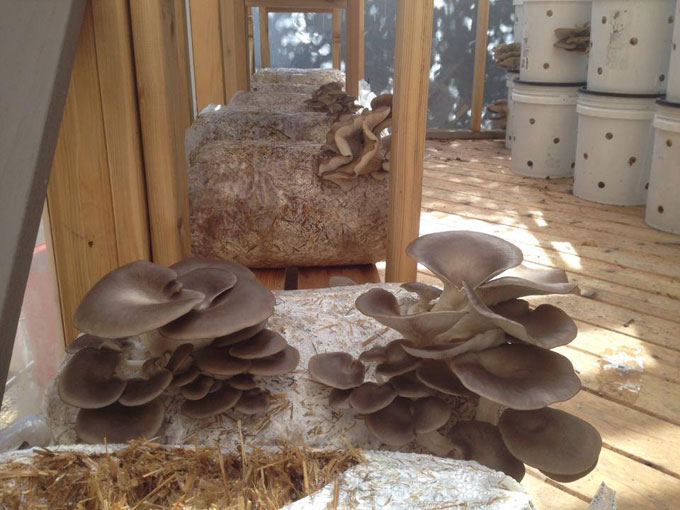Meet Robbie Giannada of Flat #12 Mushrooms
by Ethan Powers


Ain't We Got Fun(gi)
Robbie Giannada has a fungus problem in his basement. It’s not that he can’t stop it from growing. It’s that he simply cannot grow enough of it.
What initially began as a do-it-yourself project meant to serve as a teaching tool for his daughter who yearned to know where mushrooms came from, Gianadda’s Flat #12 Mushrooms are generating an ever-growing buzz on Buffalo’s culinary scene. If you have dined out in the city within the past 12 months, chances are you’ve already tried them. Kaydara, Buffalo Proper, Vera, The Black Sheep, Seabar, Rue Franklin, CRaVing, Lombardo’s, and Blue Monk are all customers of Gianadda’s and frenzied consumers of his enormous Grey Dove mushrooms.
“Right now you get all of your mushrooms from either Ontario, Upstate New York, China or California,” he said. “There’s really nowhere in between. These taste better and travel better.”
Gianadda, 38, purchased his first mushroom growing kit online shortly after his 5-year old daughter, Clementine, inquired about the origins of the ingredient. The website he purchased the kit from detailed the efficiency of growing mushrooms using spent coffee grounds. Given the close proximity of his home and working environment on Cleveland Avenue to Spot Coffee on Elmwood, Gianadda saw the perfect opportunity for a lucrative hobby that would require almost no travel. Gianadda and his wife Kari have since turned their house into an impromptu office space, which not only serves Flat #12 Mushrooms in the basement, but is also utilized on the third floor by Kari who works as a clothing designer, selling her products on Etsy.
As Gianadda leads us down the driveway, we’re greeted by the “guard dog” of Flat #12—a massive Alaskan Malamute named Chancho after the stout orphan from Nacho Libre. His presence is less than terrifying. He rolls onto his back as Giannada proudly showcases his newly constructed wooden growing shed used for producing the oysters outdoors. The six-by-sixteen-foot structure is built with mesh screening that facilitates air flow and sunlight to reach around 30 buckets. The elements ultimately have a major impact on the color and quality of the final product, according to Gianadda, as cooler temperatures will produce oysters that appear shades of gray and blue while warmer weather generates mushrooms with a golden yellow or even pink hue.
“I was originally only going to grow them indoors, but demand for them kept rising, so I built this thing and it turns out people actually liked the outdoor ones better,” he said.
Gianadda leads the way inside and down the stairs into the damp basement where the majority of the growing process takes place. To begin the growing method, he pasteurizes untreated straw in a lime bath, soaking it overnight in a high pH solution. Going through both a heat and chemical pasteurization, the straw is steamed at around 162 degrees for about three hours. After cooling, scoops of the “spawn,” which are essentially rye berries soaked in water and inoculated with mycelium, are packaged together with the treated straw and the spores are able to take root. Once the mushrooms begin to “pin” outside of the package’s perforations, they’re placed outside into five-gallon buckets drilled with small holes through which the mushrooms will blossom. It then takes less than four days for the buds to grow into the giant oyster mushrooms that have the Buffalo culinary scene hysterical.
“I saw his mushrooms popping up at some other places and I immediately reached out to him,” said Chef Ed Forster of Buffalo Proper. “He gave me a sample of like 8 pounds, and we were hooked.”
Forster notes that in the short time the Franklin Street plate and pour has been open, Gianadda’s oysters have already proven to be a big hit. Currently, Forster mainly utilizes the mushrooms in a dish featuring a Pinot Noir poached, painted meadows egg, sided with a potato, Flat #12 oyster, red shiro miso seasoning, charred allium and pickled ramps.
“In my mind it’s like super comfort food,” he said.
A logical question is whether the Food and Drug Administration or the State Department of Health holds Gianadda responsible for adhering to the procedural safety regulations that the larger producers are held to.
“There are no regulations,” he said with a sardonic smirk. “When it comes to this stuff, because I’m not growing in volume yet, there aren’t any regulations. They consider me the same as like a hobbyist or a backyard gardener.”
Gianadda added that mushrooms, inherently, tend to regulate themselves through their natural fruiting process. “There’s probably less regulation on mushrooms than on anything else. The main reason being that the fruit of the mushroom doesn’t transfer pathogens.”
What results from Gianadda’s home-produced and precise growing methodology is an oyster mushroom that is more robust and naturally cultivated than what you’d normally find in stores—ingredient characteristics that are indispensible to any chef serious about his or her craft, says Forster
“We don’t feature his mushrooms because it’s cool, we feature them because they taste great and they’re always super fresh.”
The excellence of the product is channeled through Giannada, who expresses an unabashed exuberance when speaking of his creations. It had just rained, there was a cool breeze blowing and some golden rays of sunlight were shining down. “Those mushrooms that you saw growing are going to be absolutely delicious because they’re growing on a day like today,” he said.
The urban farmer is also the delivery man, carrying the newly harvested mushrooms and dropping them off at client locations throughout the city, which allows for a product that is unparalleled in terms of freshness and quality. Rue Franklin is his longest and best customer, averaging between five to ten pounds a week for almost a year now. However it was through a conversation with Chef Steve Gedra of Bistro Europa (now The Black Sheep), ironically on the very day that his first batch of oysters fruited, that encouraged Gianadda to try selling them. “Just bring them over here,” Gianadda recalls Gedra telling him. “I’ll buy every single one that you have.”
Gianadda’s hobby is now an emerging enterprise, the only challenge being the extraordinary demand. He’s currently able to produce about 48 pounds for each batch that fruits. The requests however, reach a total of nearly 500.
“The hardest part right now is telling people I don’t have enough to sell to them,” he said. “I want to be able to sell to everybody. I want to have excess. There’s so many other things you can do with mushrooms.”
Stepping outside their culinary appeal, Gianadda discusses the limitless potential for mushrooms in both medicinal and industrial applications with passion and enthusiasm worthy of a mycologist. He details how mushroom tea has had successful FDA trials in preventing the formation of cancer cells and how mushrooms hold the key to future bioremediation advancement. Petroleum-eating oyster mushrooms can remediate soil contaminated by oil spills and other species are able to remove and absorb heavy metals, including radioactive isotopes, from soil, potentially making them an effective combatant of nuclear waste. Mushrooms are even being utilized as storm water runoff filters for farming, negating cross-contamination as mycelium biomass can be planted as an effective filter to nitrogen-borne bacteria including E. coli.
The industrial functions of oysters as they pertain to bioremediation could have extra relevance here in Buffalo, says Gianadda, as the city has a number of brownfield sites that have long since been contaminated with petroleum-based pollutants—an opportunity that could present his business with unprecedented expansion.
“Yeah,” he says with a wry smile on the possibility of seeing Flat #12 become Flat #12 Inc. “That’d be pretty cool. And it’s definitely possible. There’s unlimited growth potential here.”
Gianadda is now searching for a new warehouse space. He wants 5,000-10,000 square feet and would like to purchase heavy machinery that could automate some of the labor process. In addition to researching the possibility of adding the Shiitake and Enoki varieties to his repertoire, his goal is to produce 500 pounds a week by the end of next year.
Currently, the easiest way to try Buffalo’s new favorite fungi is to dine at one of the restaurants which Gianadda delivers to, though he does have plans in the works to make his oysters available in a retail setting, noting that Wegmans is the long-term goal and the perfect locally-emphasized environment to sell his product to a mass consumer market. Flat #12 mushrooms do occasionally hit the shelves of the Lexington Co-op, but his first 30-pound retail shipment was completely sold out in less than a week.
And to Gianadda, freshness is only a part of the reason why Buffalonians are so eager to consume a fungus grown in a basement on Cleveland Avenue.
“The composition of the air quality in Buffalo and the latitude at which the sunlight hits the earth is specific to this space. The sun hits the earth at a different way here. So I really am selling a little chunk of Buffalo. The mushroom is like the capsule.”
blog comments powered by Disqus|
Issue Navigation> Issue Index > v13n39 (Week of Thursday, September 25) > Meet Robbie Giannada of Flat #12 Mushrooms This Week's Issue • Artvoice Daily • Artvoice TV • Events Calendar • Classifieds |









 Current Issue
Current Issue